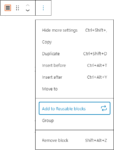Sorting Out Gutenberg Block Patterns and Reusable Blocks
kitty kitty CATegory Commentary
No Comments
Scroll down and leave a comment.
In the previous post, I recommended two free plugins that made using the block editor easier and more fun. This time we’re going to look at some of the things that you could do to make the editor easier to use. Also, there’s some things that I think could and should be done by the development team to make the block editor better and easier to use.
Block Patterns and Reusable Blocks
If you haven’t looked into Block Patters and Reusable Blocks in the Gutenberg editor yet, you’re missing some of the best features that the editor has to offer.
I’m not a developer, so there might be more going on under the covers than I think. That said, I’m going to continue forward and do my best.
Reusable Blocks
Sometimes you have some content that you want to appear in multiple locations on your website and you want it to be exactly the same in each location. This is a good use case for reusable blocks.
Reusable blocks allow you to create a freeze-dried chunk of content that you can drop into your website, anywhere it’s needed. Each reusable block can be a collection of individual blocks or a single block.
Examples of uses could include promotion for your newsletter, a special sale in your online store, any call-to-action information, and contact information, etc.
If you want to create your very own custom reusable block, just click on the three does on the block’s header, then select Add to Reusable blocks. Then whenever you’re adding a new block, you can select from the Reusable tab.
The elevator pitch for reusable blocks would be, content that you use around your website, where when changed, will change all locations.
Block Patterns
Sometimes you want a starting point for creating content. This is where block patterns shine. Once you insert a block pattern, you have the scaffolding in place and just need to alter the content to suit your needs.
Currently, there is no easy way for a regular person to create a block pattern. There’s a few plugins in the plugin repository that will allow you to make block patterns yourself and wordpress.org has a pattern repository that will allow you to copy and paste patterns. Neither one of these methods is optimal.
The elevator pitch for block patterns would be, drop in small content structures to give you a head start. Once added, all you need to do is customize the content to your needs.
Why Are These Two Separate Things?
Again, let me just restate that I am not a developer 🙂
From my point of view, Block Patterns and Reusable Blocks are almost the same thing. The only difference that I see is that Reusable Blocks are synchronized, so any change is reflected in all instances of the block.
Why don’t we have one interface to create both?
At the very least, let’s change the name of Reusable Blocks to reflect the fact that if you change the block it’s updated everywhere it’s used. Perhaps something like “Synchronized Blocks”?
One More Thing
Whether or not we see an overhaul of the Block Patterns and Reusable Blocks to make them easier to manage with a single interface it would be great to extend Block Patterns by having them be assignable to different content types.
Let’s say you’ve created a website for a client and you’ve encouraged them to blog. Each and every time they create a blog, they’ll be greeted with a blank slate where they must build their blog post from scratch. As the web developer, you should be able to create a Block Pattern (or several) and make them automatically available to the poster to make their life easier.
Yes, kind of like post formats 🙂 but different because it’s Gutenberg.

